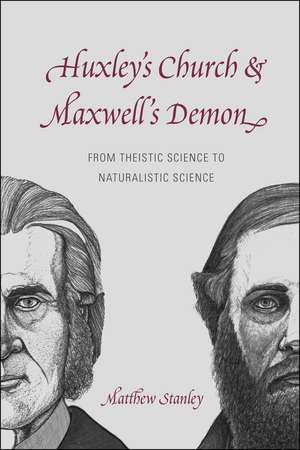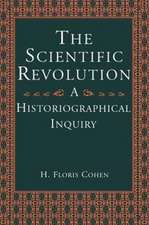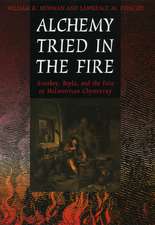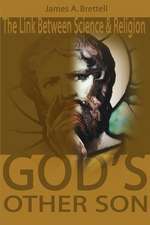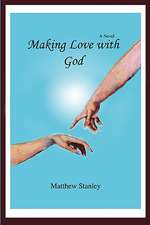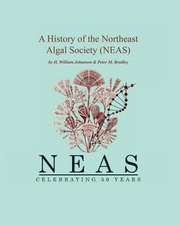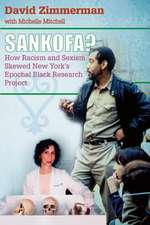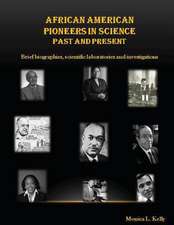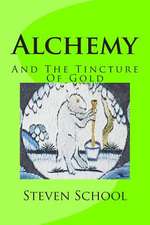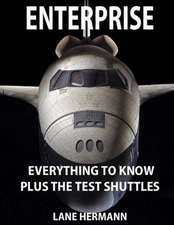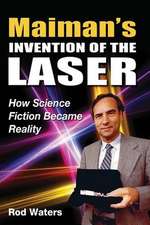Huxley's Church and Maxwell's Demon: From Theistic Science to Naturalistic Science
Autor Matthew Stanleyen Limba Engleză Paperback – 3 noi 2016
During the Victorian period, the practice of science shifted from a religious context to a naturalistic one. It is generally assumed that this shift occurred because naturalistic science was distinct from and superior to theistic science. Yet as Huxley’s Church and Maxwell’s Demon reveals, most of the methodological values underlying scientific practice were virtually identical for the theists and the naturalists: each agreed on the importance of the uniformity of natural laws, the use of hypothesis and theory, the moral value of science, and intellectual freedom. But if scientific naturalism did not rise to dominance because of its methodological superiority, then how did it triumph?
Matthew Stanley explores the overlap and shift between theistic and naturalistic science through a parallel study of two major scientific figures: James Clerk Maxwell, a devout Christian physicist, and Thomas Henry Huxley, the iconoclast biologist who coined the word agnostic. Both were deeply engaged in the methodological, institutional, and political issues that were crucial to the theistic-naturalistic transformation. What Stanley’s analysis of these figures reveals is that the scientific naturalists executed a number of strategies over a generation to gain control of the institutions of scientific education and to reimagine the history of their discipline. Rather than a sudden revolution, the similarity between theistic and naturalistic science allowed for a relatively smooth transition in practice from the old guard to the new.
Matthew Stanley explores the overlap and shift between theistic and naturalistic science through a parallel study of two major scientific figures: James Clerk Maxwell, a devout Christian physicist, and Thomas Henry Huxley, the iconoclast biologist who coined the word agnostic. Both were deeply engaged in the methodological, institutional, and political issues that were crucial to the theistic-naturalistic transformation. What Stanley’s analysis of these figures reveals is that the scientific naturalists executed a number of strategies over a generation to gain control of the institutions of scientific education and to reimagine the history of their discipline. Rather than a sudden revolution, the similarity between theistic and naturalistic science allowed for a relatively smooth transition in practice from the old guard to the new.
Preț: 235.76 lei
Nou
Puncte Express: 354
Preț estimativ în valută:
45.12€ • 46.82$ • 37.71£
45.12€ • 46.82$ • 37.71£
Carte tipărită la comandă
Livrare economică 17-31 martie
Preluare comenzi: 021 569.72.76
Specificații
ISBN-13: 9780226422336
ISBN-10: 022642233X
Pagini: 336
Ilustrații: 2 halftones
Dimensiuni: 152 x 229 x 23 mm
Greutate: 0.51 kg
Editura: University of Chicago Press
Colecția University of Chicago Press
ISBN-10: 022642233X
Pagini: 336
Ilustrații: 2 halftones
Dimensiuni: 152 x 229 x 23 mm
Greutate: 0.51 kg
Editura: University of Chicago Press
Colecția University of Chicago Press
Notă biografică
Matthew Stanley is associate professor at New York University’s Gallatin School of Individualized Study. He is the author of Practical Mystic: Religion, Science, and A. S. Eddington and lives in New York City.
Cuprins
Introduction
Chapter 1 Religious Lives
Chapter 2 The Uniformity of Natural Laws
Chapter 3 The Limits of Science
Chapter 4 The Goals of Science Education: The Working Men’s College
Chapter 5 Intellectual Freedom
Chapter 6 Free Will and Natural Laws
Chapter 7 How the Naturalists “Won”
Conclusion
Acknowledgments
Notes
Bibliography
Index
Chapter 1 Religious Lives
Chapter 2 The Uniformity of Natural Laws
Chapter 3 The Limits of Science
Chapter 4 The Goals of Science Education: The Working Men’s College
Chapter 5 Intellectual Freedom
Chapter 6 Free Will and Natural Laws
Chapter 7 How the Naturalists “Won”
Conclusion
Acknowledgments
Notes
Bibliography
Index
Recenzii
“Matthew Stanley has written an absorbing, meticulously researched book that usefully complicates our understanding of the exclusion of God as an explanatory agent from the sciences. Using James Clerk Maxwell and Thomas H. Huxley as representative figures, he shows that for much of the nineteenth century proponents of theistic science and scientific naturalism in Great Britain worked side by side and shared similar views of the uniformity of nature, the limits of scientific investigation, and the values and goals of science education. Stanley rejects the notion that the triumph of “methodological naturalism” in science was the result of a victory of enlightenment over obscurantism; it was rather the result of shrewd strategic decisions on the part of scientific naturalists. A stimulating and persuasive account of Victorian scientific theory and practice.”
"The context of Victorian science swung smoothly from the theistic to the naturalistic, shedding supernatural causality along the way. Stanley attributes the relative amity between Christian and atheist scientists to shared ideals such as intellectual freedom."
"Matthew Stanley’s wonderful new book introduces us to Maxwell and Huxley as they embodied theistic and naturalistic science, respectively, in Victorian Britain. Moving well beyond the widespread assumption that modern science and religion are and always have been fundamentally antithetical to one another, Huxley’s Church & Maxwell’s Demon offers a history of scientific naturalism that illustrates the deep and fundamental commonalities between positions on the proper practice of science that began to diverge relatively late and in very particular historical circumstances."
"Stanley’s new book addresses the 'science and religion' trope head-on and in a genuinely historical way. The style of the book is fundamentally that of intellectual history: the use of Huxley and Maxwell as its chief protagonists allows a close engagement with specific arguments and strategies, with appropriate contextual material provided to make sense of them. There is rich material in Huxley’s Church and Maxwell’s Demon and numerous avenues for further
investigation."
investigation."
"Today there is hardly a serious scientist who incorporates God into his/her scientific research or publication. This was not always so. If not explicitly, at least as a backdrop, God was always in the minds of a vast number of scientists until even the end of the 19th century. The shift from the worldview of a God-created universe to one that is completely naturalistic, with neither need for nor nurturing of divinity to formulate natural laws and endow humans with intelligence was a slow process. How this happened and the major role played by key British thinkers (many more than the heroes in the title) is the theme of this fascinating book. This was a victory of philosophical reflection (symbolized by T. H. Huxley) over technical science (symbolized by J. C. Maxwell). With telling irony, the atheistic Huxley's school is described as a church, and the theistic Maxwell's physics is referred to in terms of his demon. Stanley presents an insightful narrative in this thorough, erudite work. It will become a milestone in the history of science scholarship."
"A valuable addition to the flourishing historical scholarship on science and religion."
Nothing characterizes modern science more than its rejection of appeals to God in explaining the workings of nature. Nevertheless, historians have written relatively little about the development of this methodological practice. Stanley’s Huxley’s Church and Maxwell’s Demon vividly describes how nineteenth-century British naturalists won the victory over their theistic rivals. It stands as a major contribution to the literature on the history of science and religion.”
“Concentrating on two towering intellectual figures, James Clerk Maxwell and Thomas Henry Huxley, Stanley offers an innovative perspective on late nineteenth-century British science in which he deploys an original argument to challenge the controversial view that science and religion were—and still are—in conflict. Instead, through a careful reading of Maxwell, Huxley, and several of their contemporaries, Stanley shows that there were major areas of agreement between those who adopted a theistic approach to science and the rising band of naturalists, who viewed the natural world as governed by nothing other than a collection of laws. By emphasizing points of agreement—for example, over the uniformity of nature—Stanley also throws the differences between these two approaches into clearer relief. Moreover, he provides a nuanced, sensitive, and firmly grounded understanding of both Huxley and Maxwell, and one that not only undermines the conflict thesis but also provides the reader with a deeper understanding of the interrelations between science and religion. An impressive achievement!”
“In his penetrating study of the methodological values of Victorian scientists, Stanley has carefully traced the process whereby religious ideas and values were pushed out of scientific practice. He argues that science became naturalistic with relatively little bloodshed despite the heated controversies over evolutionary theory. Naturalistic scientists like Thomas Henry Huxley shrewdly adapted the methodological values of theistic science, which included such principles as the uniformity of nature, the limits of scientific knowledge, the moral value of science, and intellectual freedom. Then, through the use of institutional strategies, they gained control of science and thoroughly naturalized how research was conducted. They succeeded so well that today it is difficult to conceive of science as anything other than naturalistic. Stanley’s provocative book offers a fresh perspective on the complex relationship between naturalism and theism both now and in the nineteenth century.”
Descriere
During the Victorian period, the practice of science shifted from a religious context to a naturalistic one. It is generally assumed that this shift occurred because naturalistic science was distinct from and superior to theistic science. Yet as Huxley’s Church and Maxwell’s Demon reveals, most of the methodological values underlying scientific practice were virtually identical for the theists and the naturalists: each agreed on the importance of the uniformity of natural laws, the use of hypothesis and theory, the moral value of science, and intellectual freedom. But if scientific naturalism did not rise to dominance because of its methodological superiority, then how did it triumph?
Matthew Stanley explores the overlap and shift between theistic and naturalistic science through a parallel study of two major scientific figures: James Clerk Maxwell, a devout Christian physicist, and Thomas Henry Huxley, the iconoclast biologist who coined the word agnostic. Both were deeply engaged in the methodological, institutional, and political issues that were crucial to the theistic-naturalistic transformation. What Stanley’s analysis of these figures reveals is that the scientific naturalists executed a number of strategies over a generation to gain control of the institutions of scientific education and to reimagine the history of their discipline. Rather than a sudden revolution, the similarity between theistic and naturalistic science allowed for a relatively smooth transition in practice from the old guard to the new.
Matthew Stanley explores the overlap and shift between theistic and naturalistic science through a parallel study of two major scientific figures: James Clerk Maxwell, a devout Christian physicist, and Thomas Henry Huxley, the iconoclast biologist who coined the word agnostic. Both were deeply engaged in the methodological, institutional, and political issues that were crucial to the theistic-naturalistic transformation. What Stanley’s analysis of these figures reveals is that the scientific naturalists executed a number of strategies over a generation to gain control of the institutions of scientific education and to reimagine the history of their discipline. Rather than a sudden revolution, the similarity between theistic and naturalistic science allowed for a relatively smooth transition in practice from the old guard to the new.
